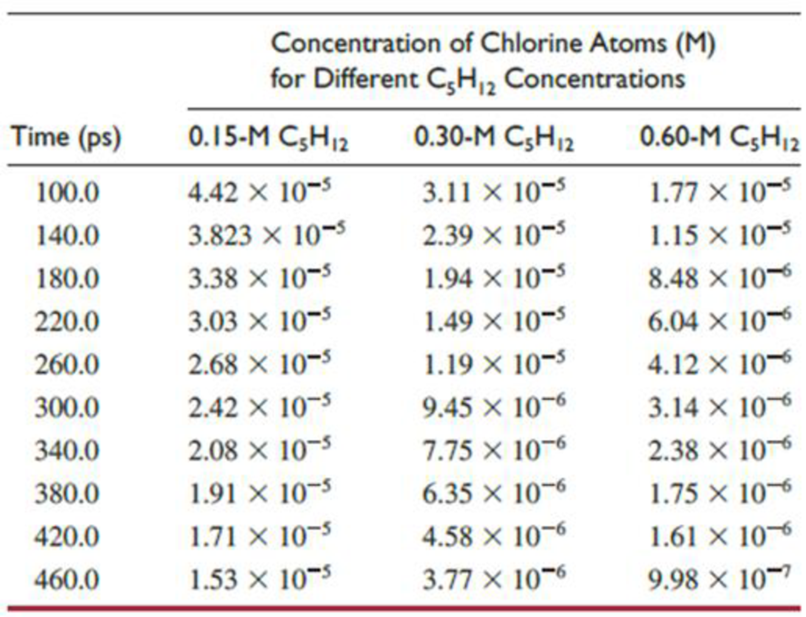
In a time-resolved picosecond spectroscopy experiment, Sheps, Crowther, Carrier, and Crim (Journal of
Cl · (dcm) + C5H12(dcm) → HCl(dcm) + C5H11 · (dcm)
where (dcm) indicates that a substance is dissolved in dichloromethane. Measurements of the concentration of chlorine atoms were made as a function of time at three different concentrations of pentane in the dichloromethane. These results are shown in the table.

- (a) Determine the order of the reaction with respect to chlorine.
- (b) Determine whether the reaction rate depends on the concentration of pentane in dichloromethane. If so, determine the order of the reaction with respect to pentane.
- (c) Explain why the concentration of pentane in dichloromethane does not affect the data analysis that you performed in part (a).
- (d) Write the rate law for the reaction and calculate the
rate of reaction for a concentration of chlorine atoms equal to 1.0 μM and a pentane concentration of 0.23 M. - (e) Sheps, Crowther, Carrier, and Crim found that the rate of formation of HCl matched the rate of disappearance of Cl. From this they concluded that there were no intermediates and side reactions were not important. Explain the basis for this conclusion.
Want to see the full answer?
Check out a sample textbook solution
Chapter 11 Solutions
Chemistry: The Molecular Science
- The acid-catalyzed iodination of acetone CH3COCH3(aq) + I2(aq) CH3COCH2I(aq) + HI(aq) is a common laboratory experiment used in general chemistry courses to teach the method of initial rates. The reaction is followed spectrophotometrically by the disappearance of the color of iodine in the solution. The following data (J. P. Birk and D. L Walters, Journal of Chemical Education, Vol. 69, p. 585, 1992) were collected at 23 C for this reaction. Determine the rate law for this reaction.arrow_forwardThe rate of photodecomposition of the herbicide piclo- ram in aqueous systems was determined by exposure to sunlight for a number of days. One such experiment produced the following results. (Data from R.T. Hedlun and C.R. Youngson, “The Rates of Photodecomposition of Picloram in Aqueous Systems," Fate of Organic Pesticides in tbe Aquatic Environment, Advances in Chemistry Series, #111, American Chemical Society (1972), 159—172.) Exposure Time, t (days) [Pidoram] (mol L_1) 0 4.14 X 10-6 7 3.70 X 10-6 14 3.31 X 10-6 21 2.94 X 10~6 28 2.61 X 10~6 35 2.30 X 10-6 42 2.05 X 10-6 49 1.82 X 10"6 56 1.65 X 10-6 Determine the order of reaction, the rate constant, and the half-life for the photodecomposition of picloram.arrow_forwardLabel the elementary processes for the reaction between H2 and O2 see section 20.7 as initiation, propagation, branching, or termination reactions.arrow_forward
- Define stability from both a kinetic and thermodynamic perspective. Give examples to show the differences in these concepts.arrow_forwardExplain why half-lives are not normally used to describe reactions other than first order.arrow_forwardThe oxidation of iodide ion by the hypochlorite ion in the presence of hydroxide ions I(aq) + ClO(aq) IO(aq) + Cl(aq) was studied at 25 C, and the following initial rates data (Y. Chia and R. E. Connick, Journal of Physical Chemistry, Vol. 63, p. 1518, 1959) were collected: (a) Determine the rate law for this reaction. (b) One mechanism that has been proposed for this reaction is the following: Show that the rate law predicted by this mechanism matches the experimentally determined rate law in part a. (Note that when writing the expression for K the equilibrium constant, [H2O] is not involved. See Chapter 15.)arrow_forward
- For the past 10 years, the unsaturated hydrocarbon 1, 3-butadiene (CH2 = CH - CH = CH2) has ranked 38th among the top 50 industrial Chemicals. It is used primarily for the manufacture of synthetic rubber. An isomer exists also as cyclobutene: The isomerization of cyclobutene to butadiene is first-order and the rate constant has been measured as 2.0104s1 at 150 C in a 0.53-L ?ask. Determine the partial pressure of cyclobutene and its concentration after 30.0 minutes if an isomerization reaction is carried out at 150 C with an initial pressure of 55 torr.arrow_forwardWhen enzymes are present at very low concentration, their effect on reaction rate can be described by first-order kinetics. Calculate by what factor the rate of an enzyme-catalyzed reaction changes when the enzyme concentration is changed from 1.5 107 M to 4.5 106 M.arrow_forwardWhen formic acid is heated, it decomposes to hydrogen and carbon dioxide in a first-order decay: HCOOH(g)CO2(g)+H2(g) The rate of reaction is monitored by measuring the total pressure in the reaction container. Time (s) Pressure (torr) 0 220 50 324 100 379 150 408 200 423 250 431 300 435 Calculate the rate constant and half-life in seconds for the reaction. At the start of the reaction (time = 0), only formic acid is present. (HINT: Find the partial pressure of formic acid using Dalton's law of partial pressure and the reaction stoichiometry to find PHCOOH at each time.)arrow_forward
 Chemistry: The Molecular ScienceChemistryISBN:9781285199047Author:John W. Moore, Conrad L. StanitskiPublisher:Cengage Learning
Chemistry: The Molecular ScienceChemistryISBN:9781285199047Author:John W. Moore, Conrad L. StanitskiPublisher:Cengage Learning Chemistry for Engineering StudentsChemistryISBN:9781337398909Author:Lawrence S. Brown, Tom HolmePublisher:Cengage Learning
Chemistry for Engineering StudentsChemistryISBN:9781337398909Author:Lawrence S. Brown, Tom HolmePublisher:Cengage Learning Chemistry & Chemical ReactivityChemistryISBN:9781133949640Author:John C. Kotz, Paul M. Treichel, John Townsend, David TreichelPublisher:Cengage Learning
Chemistry & Chemical ReactivityChemistryISBN:9781133949640Author:John C. Kotz, Paul M. Treichel, John Townsend, David TreichelPublisher:Cengage Learning Chemistry & Chemical ReactivityChemistryISBN:9781337399074Author:John C. Kotz, Paul M. Treichel, John Townsend, David TreichelPublisher:Cengage Learning
Chemistry & Chemical ReactivityChemistryISBN:9781337399074Author:John C. Kotz, Paul M. Treichel, John Townsend, David TreichelPublisher:Cengage Learning Chemistry by OpenStax (2015-05-04)ChemistryISBN:9781938168390Author:Klaus Theopold, Richard H Langley, Paul Flowers, William R. Robinson, Mark BlaserPublisher:OpenStax
Chemistry by OpenStax (2015-05-04)ChemistryISBN:9781938168390Author:Klaus Theopold, Richard H Langley, Paul Flowers, William R. Robinson, Mark BlaserPublisher:OpenStax Chemistry: Principles and PracticeChemistryISBN:9780534420123Author:Daniel L. Reger, Scott R. Goode, David W. Ball, Edward MercerPublisher:Cengage Learning
Chemistry: Principles and PracticeChemistryISBN:9780534420123Author:Daniel L. Reger, Scott R. Goode, David W. Ball, Edward MercerPublisher:Cengage Learning





